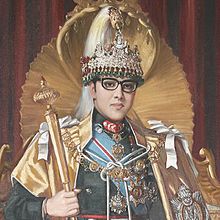Coronation of Birendra

Birendra was crowned as the tenth King of Nepal on 24 February 1975,[1][2] at the age of 29. The coronation was held two years after the death of his father, King Mahendra because the first year was a year of mourning period and the next was considered inauspicious by court astrologers.[3] Representatives from 60 nations attended the ceremony.
Ceremony[edit]
The coronation was held in Hanuman Dhoka at Kathmandu Durbar Square. All the buildings and temples on main roads were whitewashed and restored. All the hippies and foreign tourists were taken out of the Durbar Square.[4]
The coronation was done following Hindu rituals as the King is considered as an incarnation of Vishnu, one of the principal Hindu deities. Several key rituals were administered by priest privately to the King and Queen only.
In a day before coronation a ritual, called Purvanga was performed at Hanuman Dhoka. Birendra sat on a cloth mat in the courtyard. The ritual involved offering rice, barley and wheat to gods and ancestors while a group of Hindu priests chanted Vinayaka. Then the priests called for ancestral blessings by praying to the planets including Jupiter and Mars. During the prayer, Queen Aishwarya sat beside the King.[3]
The next day, a parade of Nepalese military units, musical bands and bagpipes followed by a six horsed carriage, a gift from Queen Elizabeth II,[5] carried the royal couple to Hanuman Dhoka. There, the King was smeared with mud from a dozen locations such as hills, rivers, farms and temples symbolizing that the new king is aware of his land. Then he ritually bathed with cow milk, yogurt, butter and honey. After cleaning, the king moved to sit in the golden throne while the priest chanted sacred Vedic mantras. The king bowed to the royal priest (Raj Guru). The Raj Guru then placed the royal crown on the head of Birendra at the auspicious moment of 8:37 am determined by the court astrologers.[4] The king vowed “I shall tend to the growth of the country, regarding it as God himself. I shall remain alert and active for the sake of my country. I shall be my peoples’ beloved, like the raindrops.” in Sanskrit. cannon salvos were fired to indicate the ceremony had been conducted. Later in the day, king rode an elephant named Prem Prasad draped in velvet cloth, gold and silver and visited temples and places near the palace. Another 22 elephants followed the king carrying the guests.[4] Citizens lined in road to see the king. Crown Prince Dipendra was wearing a military uniform.[6]
Notable guests[edit]
The guest included representatives from 60 nations.[3] Some of them were:
- Philip W. Buchen, counsel of US President Ford
- Charles H. Percy, Senator from lillinois, US
- Carol C. Laise, Assistant Secretary of State for Public Affairs, US
- The Prince of Wales, UK
- Crown Prince Akihito, Japan
- Sir John Kerr, Governor General of Australia
- William Gopallawa, President of Sri Lanka
- Fazal Ilahi Chaudhry, President of Pakistan
- B. D. Jatti, Vice President of India
- Imelda Marcos, wife of Philippine President Ferdinand E. Marcos
- The Duke and Duchess of Gloucester, UK
- Lord Mountbatten, UK
- Prince Henrik of Denmark
- Vong Savang, Crown Prince of Laos
Significances[edit]
The attendance of the Indian Vice President, B. D. Jatti, instead of the Indian President, Fakhruddin Ali Ahmed, was seen as a move against the protest in Nepal when India took over the Kingdom of Sikkim.[4]
See also[edit]
References[edit]
- ^ Times, Bernard Weinraub; Special to The New York (1975-02-24). "World's Only Hindu King Is Crowned in Nepal Ritual". The New York Times. ISSN 0362-4331. Retrieved 2023-05-08.
{{cite news}}: CS1 maint: multiple names: authors list (link) - ^ Chaulangain, Nawaraj. Coronation of the Hindu king. p. 12-30.
- ^ a b c Times, Bernard Weinraub; Special to The New York (1975-02-23). "Nepal Begins Ritual Of Royal Coronation". The New York Times. ISSN 0362-4331. Retrieved 2022-07-23.
{{cite news}}: CS1 maint: multiple names: authors list (link) - ^ a b c d "NEPAL: Coronation in Katmandu - TIME". Time. 10 March 1975. Retrieved 2022-07-23.
- ^ diwakar (2021-09-06). "Narayanhiti Palace Museum unveils King Birendra's coronation carriage after 46 years - OnlineKhabar English News". Retrieved 2022-07-23.
- ^ Times, Bernard Weinraub; Special to The New York (1975-02-24). "World's Only Hindu King Is Crowned in Nepal Ritual". The New York Times. ISSN 0362-4331. Retrieved 2022-07-23.
{{cite news}}: CS1 maint: multiple names: authors list (link)
